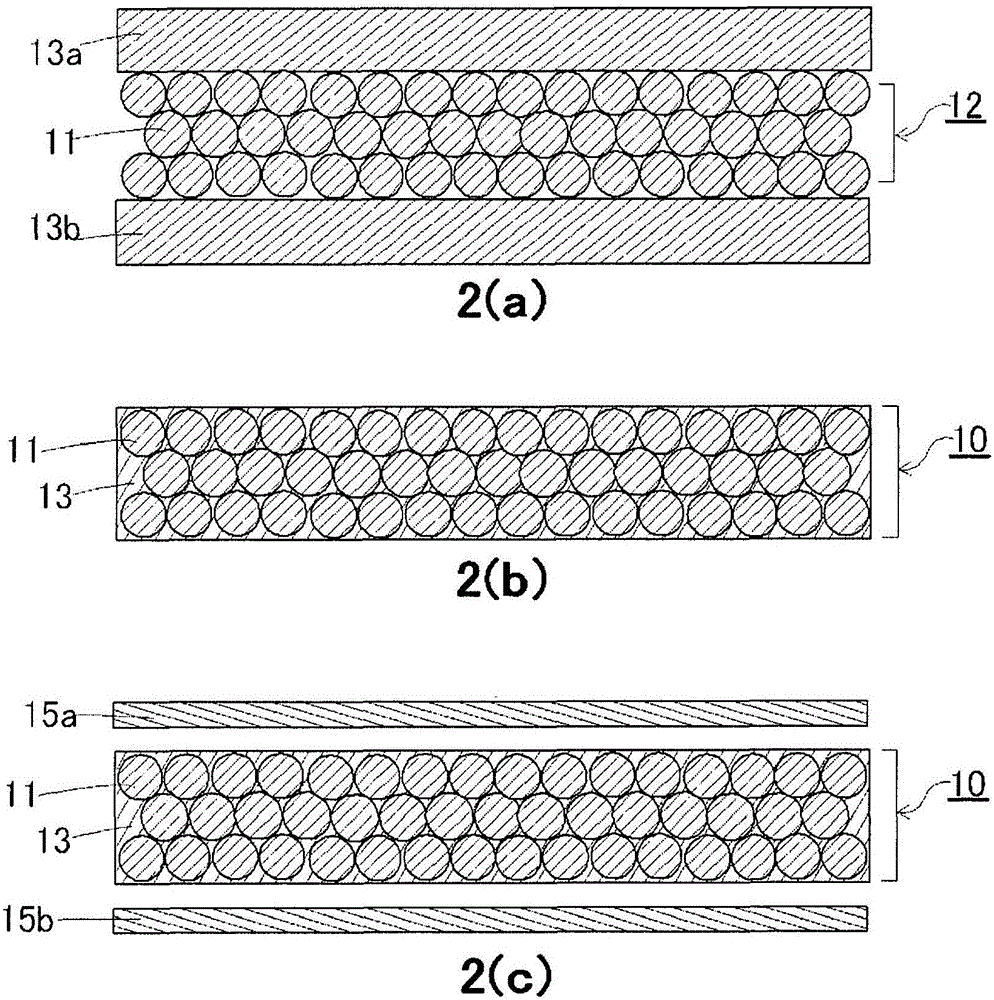Prepreg and method for producing same
A technology of prepreg and epoxy resin, applied in the direction of chemical instruments and methods, thin material processing, synthetic resin layered products, etc., can solve the problems of CFRP impact resistance and conductivity, CFRP breakdown, and CFRP conductivity reduction and other problems, to achieve excellent electrical conductivity and impact resistance, and to improve electrical conductivity
- Summary
- Abstract
- Description
- Claims
- Application Information
AI Technical Summary
Problems solved by technology
Method used
Image
Examples
Embodiment 1、2
[0322] According to the ratio described in Table 1, the thermoplastic resin was dissolved in the epoxy resin at 120° C. using a stirrer. Then, the temperature was lowered to 80° C., the conductive particles were added and mixed for 30 minutes, and the epoxy resin composition [A] was prepared.
[0323] 10 parts by mass of Ultem 1000-1000 were dissolved in the epoxy resin at 120° C. using a stirrer at the ratio described in Table 1. Then, the temperature was lowered to 80° C., the remaining thermoplastic resin and curing agent were added, and mixed for 30 minutes to prepare an epoxy resin composition [B].
[0324] Epoxy resin composition [A] and epoxy resin composition [B] are coated on release film respectively using film coating machine, obtain resin [A] sheet and resin [A] of mass per unit area shown in Table 1 B] sheet.
[0325] Next, between the two resin [B] sheets, the above-mentioned carbon fiber bundles are supplied so as to be uniformly arranged in the same direction...
Embodiment 3~5
[0333] A prepreg was produced in the same manner as in Example 1 except that the thermoplastic resins used in the epoxy resin composition [A] and epoxy resin composition [B] were changed as described in Table 1. Various properties of the obtained prepregs are shown in Table 1.
[0334]In Examples 3 to 5 in which the type of thermoplastic resin was changed, as in Examples 1 and 2, since the thermoplastic resin was present, compared with Comparative Examples 1 and 2, the primary prepreg which was the inner layer of the prepreg was impregnated. The minimum viscosity of the resin composition in the feed is relatively high. Thus, it is difficult for the conductive particles to deposit on the inner layer of the prepreg. Therefore, for FRP produced by lamination and curing of prepregs, many conductive particles are left in the resin layer, and these particles act as conductive bridges between the reinforcing fiber layers. Therefore, the obtained FRP has a low volume resistivity in ...
Embodiment 6~11
[0337] In the ratio described in Table 2, 10 parts by mass of the epoxy resin-soluble thermoplastic resin (Ultem 1000-1000) was dissolved in the epoxy resin at 120° C. using a stirrer. Then, the temperature was lowered to 80° C., a curing agent, the remaining epoxy resin-soluble thermoplastic resin, and epoxy resin-insoluble thermoplastic resin (TR-55) were added and mixed for 30 minutes to prepare an epoxy resin composition [B]. About epoxy resin composition [A], it prepared similarly to Example 1 except having changed the addition amount of electroconductive particle. A prepreg was manufactured in the same manner as in Example 1, and the properties of the obtained prepreg are shown in Table 2.
[0338] After the prepregs obtained in Examples 6 to 11 were stored at a temperature of 26.7°C and a humidity of 65% for 10 days, their drape properties remained unchanged from those immediately after production, and their adhesiveness remained above 50%, showing excellent storage sta...
PUM
| Property | Measurement | Unit |
|---|---|---|
| particle diameter | aaaaa | aaaaa |
| particle diameter | aaaaa | aaaaa |
| tensile modulus | aaaaa | aaaaa |
Abstract
Description
Claims
Application Information
 Login to View More
Login to View More - R&D
- Intellectual Property
- Life Sciences
- Materials
- Tech Scout
- Unparalleled Data Quality
- Higher Quality Content
- 60% Fewer Hallucinations
Browse by: Latest US Patents, China's latest patents, Technical Efficacy Thesaurus, Application Domain, Technology Topic, Popular Technical Reports.
© 2025 PatSnap. All rights reserved.Legal|Privacy policy|Modern Slavery Act Transparency Statement|Sitemap|About US| Contact US: help@patsnap.com



